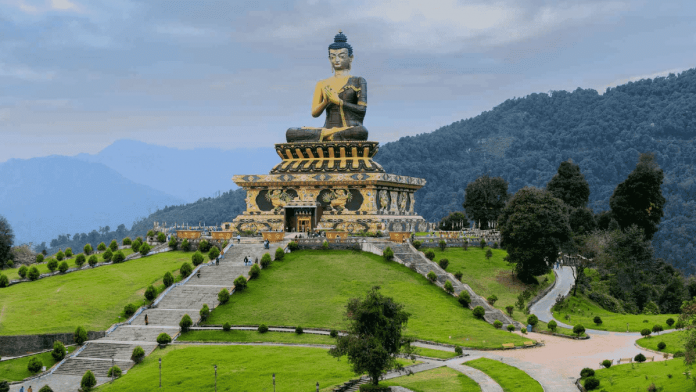In our present blog, we will be exploring the state of Sikkim. The state is synonymous with sheer magic and wonder. It is serene and at the same time the cleanest and safest place in India. Diverse flora and fauna, bounties of nature, snow-capped mountains and fast-paced development of the state make Sikkim a centre of attraction.
Which state of India has most of the population of Nepali origin? What are the geographical aspects of Sikkim?
Sikkim is an interesting and amazing landlocked Indian State located in the Himalayan Mountains with a diverse atmosphere, beautiful mountain peaks and purposeful natural phenomenon.
Let’s have a look over the State Symbols of Sikkim.
| State Capital | Gangtok |
| State Flower | Dendrobium nobile |
| State Tree | Rhododendron niveum |
| State Animal | Red panda |
| State Bird | Blood pheasant |
| State Dance | Singhi Chham |
| State Governor (PRESENT) | Ganga Prasad |
| State Chief Minister (PRESENT) | Prem Singh Tamang (incumbent) |
Now it’s time to discuss about the topmost aspect of Sikkim i.e. Culture.
Table of Contents
CULTURE Sikkim GK Notes 2021:
Modern Sikkim is a multi-ethnic and multilingual Indian state. Communities, Cultures, Religions and Customs of different shades intermingle freely in Sikkim to constitute a homogeneous blend. Sikkim has most of the population of Nepali origin. The People of Sikkim consist of three ethnic groups namely, Lepcha, Bhutia and Nepali.
- Buddhism and Hinduism are the two prominent religious practices followed by a large number of people in the state. People also follow Christianity, Islamism and Sikhism.
- Singhi Chham is a masked dance of Sikkim depicting snow lion which is the cultural symbol of the state.
- Some of the most popular festivals celebrated in Sikkim are Losoong, Drupka Teshi, Bumchu, Saga Dawa, Dassin and Phang Lhabsol.
- Nepali is spoken by the majority of the population.
- The official languages of the state are English, Nepali, Sikkimese and Lepcha. Additional official languages include Gurung, Limbu, Magar, Mukhia, Newari, Rai, Sherpa and Tamang for the purpose of preservation of culture and tradition in the state.
- Rice is a staple food, and fermented foods traditionally constitute a significant portion of the Sikkimese cuisine. Some of the famous dishes of Sikkim include Momos, Thukpa and Gundruk.
Now, let’s talk about the geographical aspects of Sikkim.
GEOGRAPHY Sikkim GK Notes 2021:
Sikkim is located in the north-eastern part of India and in the eastern Himalayas. It is one of the smallest states in India. Sikkim is characterised by mountainous terrain that is nestling in the Himalayan Mountains.
- Area: 7,096 km²
Area rank in India: 27th
- Population:610,577
Population rank in India: 28th
- Latitude: 27°04’ N to 28°07’ N
- Longitude: 88°00’E to 88°55’ E
- Sikkim has four districts, East Sikkim, West Sikkim, North Sikkim and South Sikkim.
- Sikkim is bordered by Tibet to the north and northeast, by Bhutan to the southeast, by West Bengal to the south, and by Nepal to the west.
- The Sikkim basin is drained by the Tista River and its tributaries, such as Rangit, Lhonak, Talung, and Lachung, which have cut deep valleys into the mountains.
- More than two-fifths of Sikkim is forested. Sal, pandanus, palms, bamboos, ferns, and orchids are common in the subtropical forests. In temperate forests, trees like oak, laurel, maple, chestnut, magnolia, alder, birch, rhododendron, fir, hemlock, and spruce are commonly available.
Climate:
Sikkim’s climate ranges from sub-tropical in the south to tundra in the north. The state has five seasons: winter, summer, spring, autumn, and monsoon season. The average annual temperature for most of the region of Sikkim is around 18 °C. Sikkim is one of the few states in India to receive regular snowfall. The tundra-type region in the north is snowbound for four months every year, and the temperature drops below 0 °C almost every night. During the monsoon, heavy rains increase the risk of landslides. Sikkim is one of the highest rainfall-receiving states in India. The highest annual rainfall for the state exceeds 5000 mm.
Soil Type:
The hills of Sikkim mainly consist of gneiss and schist which weather to produce generally poor and shallow brown clay soils. The soil is coarse, with large concentrations of iron oxide. It ranges from neutral to acidic and is lacking in organic and mineral nutrients.
Now, let’s study the political aspects of the state.
GOVERNMENT & POLITICS Sikkim GK Notes 2021:
The constitution of Sikkim provides for a governor as the head of state. The governor is aided by the state Council of Ministers, which is led by a chief minister. The Legislative Assembly is a unicameral elected body. The final court in the judiciary system is the High Court at Gangtok, from where appeals are made to the Supreme Court of India. The state is divided into 4 districts. Within each district, local headmen serve as head between the people and the district administration.
Representation of Sikkim in Parliament:
Assembly seats (unicameral): 32
Rajyasabha: 1
Loksabha: 1
First Governor of Sikkim: B. B. Lal
First Chief Minister of Sikkim: Kazi Lhendup Dorjee
Here comes SOME INTERESTING FACTS ABOUT SIKKIM:
- This tiny state is home to about 600 types of orchids and 240 species of trees and ferns. There are also 150 varieties of gladioli and 46 species of rhododendrons. Sikkim has about one–third of the total angiosperms found in India. Every year during the summer i.e. from March to May, International Flower Festival is held in Sikkim.
- Sikkim boasts of over 552 different species of birds and about 690 species of butterflies.
- Bhum Chu is a special holy water ceremony that takes place in the Tashiding Monastery which is one of the most sacred monasteries of Sikkim. It is said that this ceremony forecasts the future of Sikkim.
- Chaang is a fermented cereal-based mild alcoholic beverage. It is the most famous drink of Sikkim and is consumed during social activities.
Hope this blog made most of your facts clear about Sikkim. In our upcoming write-up, we will be discussing about other important aspects of Sikkim.
What is the historical background of Sikkim? Where is World’s third highest peak situated?
In our further article, the factors corresponding to these questions will be answered surely. If you don’t want to miss it, click here – Know your State ‘Sikkim’ – Part 2. We hope it will help you in the preparation of your competitive exams such SSC 10+2, SSC CGL, CDS, NDA, etc.
Thank You




